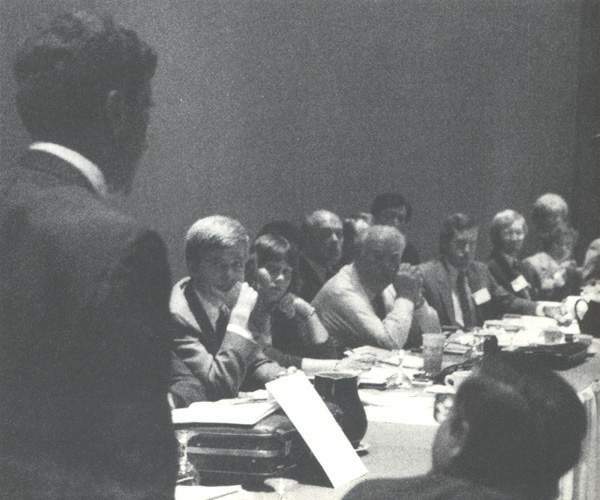|
The Slope System Becomes Official and Other Changes
1987 USGA Handicap Committee Report
From the USGA Annual Report
by Montford T. Johnson
Chairman
The first USGA Handicap System was introduced in 1912 so that golfers of varying levels of skill could compete equitably and better enjoy the game of golf. Over the years, the system has been refined but it remains among the USGA's most important functions and accomplishments.
After four years of extensive testing by regional and state golf associations, the Slope System becomes part of the USGA Handicap System in 1987. Slope, explained in the new edition of the USGA Handicap System Manual, represents one of the most significant improvements to the Handicap System. It is a unique departure from the traditional concept that a golfer receives the same number of handicap strokes at every golf course.
Even though each course has an accurate Course Rating, non-expert players naturally would develop higher handicaps at difficult courses than they would develop at easier courses. This fact created a fundamental problem with respect to the "portability" of handicaps. The Slope System provides a solution to that problem. A golfer using the USGA Slope System converts his "USGA Handicap Index" to a Course Handicap that is higher on more difficult courses (that is, on a higher than average Slope-rated course), and lower on easier courses (that is, lower Slope-rated courses).
In 1987, two million golfers from 9,000 golf clubs nationwide will use the Slope System, and 75 of the 81 authorized golf associations that have issued Slope Ratings will use the system. This is a good start for the first year of implementation.
I am grateful for the hard work performed by Dr. Richard Stroud and the USGA Men's Handicap Procedure Committee, and Ann Beard and the USGA Women's Handicap Procedure Committee in developing refinements to the USGA Handicap System.
Highlights of changes in the USGA Handicap System for 1987 are listed below:
The Slope System
The USGA Slope System produces a USGA Handicap Index rather than simply a USGA Handicap. A USGA Handicap Index is always expressed as strokes and decimal fractions of a stroke and is converted to a whole number "Course Handicap" for the particular course being played by means of a Course Handicap Table. Golf associations have the option of using the Slope System.
Scores for Incompleted Rounds
The USGA Handicap System has been amended to provide that if a player does not complete a round, but plays 13 or more holes, he shall record a score for that partial round for handicap purposes. This is done by adding the number of strokes played to the total of par for the unplayed holes plus any handicap strokes to which he is entitled on the unplayed holes. Prior to this amendment, scores from incompleted rounds were not acceptable.
Scores on Short Courses
The USGA Handicap System has been amended to eliminate the requirement that a majority of holes on a course must be par-4s and par-5s in order for scores to be acceptable for handicap purposes. Scores are now acceptable for handicap purposes if achieved on a course which is at least 5,000 yards long (4,000 yards for women). In areas where the Slope System is used a course must be at least 3,000 yards long for men or women for scores to be acceptable.
Age Limit on Scores
The USGA Handicap System has been amended to eliminate the provision prohibiting use of scores for handicap computation which were made prior to the current year and the two immediately preceding years. This means that even an old score is better than no score at all.
Multi-ball Scores
The USGA Handicap System has been amended to eliminate the provision which allowed a Handicap Committee to prohibit return of scores made in multi-ball events in which players have been requested to pick-up when out of contention. Now a committee shall require that these scores be posted for handicap purposes, using Equitable Stroke Control as appropriate. (Dean's Note: The current concept of posting most likely score when a hole was not completed came along a few years later).
The USGA's Golf Handicap and Information Network (GHIN) continues to be recognized as a high quality handicap computation service. GHIN was used by 31 regional golf associations in 1986, and provided handicaps to approximately 600,000 golfers. Annual GHIN Service surveys received from thousands of club handicap chairmen indicated that they rated the service from excellent to outstanding. The annual GHIN Users' Meeting of golf association representatives adopted additional refinements for 1987.
It is gratifying to recognize that the USGA Handicap System has earned trust and respect throughout the United States. And 1987 should prove to be the year that Dean Knuth, our Director of Handicapping, and I can answer, "Yes," when asked whether we are having fun yet.
 DEAN KNUTH, the USGA's Director of Handicapping, gets rapt attention at a meeting of associations using the Golf Handicap and Information Network (GHIN). DEAN KNUTH, the USGA's Director of Handicapping, gets rapt attention at a meeting of associations using the Golf Handicap and Information Network (GHIN).
|






